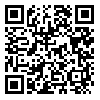Volume 9, Issue 18 (2023)
QHTS 2023, 9(18): 377-407 |
Back to browse issues page
Download citation:
BibTeX | RIS | EndNote | Medlars | ProCite | Reference Manager | RefWorks
Send citation to:



BibTeX | RIS | EndNote | Medlars | ProCite | Reference Manager | RefWorks
Send citation to:
Mohases M, Masnavi M. Finding Equivalence for the Conceptual Metaphors "Clothing" and "Harvest" Regarding Women in Quran Translations. QHTS 2023; 9 (18) :377-407
URL: http://qhts.modares.ac.ir/article-10-71491-en.html
URL: http://qhts.modares.ac.ir/article-10-71491-en.html
1- Member of the faculty of Shahid Beheshti University, Faculty of Theology and Religions , m_mohases@sbu.ac.ir
2- Allameh Tabatabaei University
2- Allameh Tabatabaei University
Abstract: (1146 Views)
Based on recent findings in cognitive sciences, the human mind uses everyday sensory experiences to represent abstract concepts based on concrete concepts. The Quran also exhibits abundant evidence of this conceptualization method. The present study examines two verses from the Quran that are crucial in metaphorical conceptualizations about women and analyzes in the translations of Bakhtiyar and Saffarzadeh in English, as well as recent Persian translations. These metaphors have evolved within a broad spectrum of cultural perceptions and are influenced by prevalent experiences during the time of the Quran's revelation. Concepts such as "Clothing" and "Harvest" are among the fundamental domains that the Quran has utilized to conceptualize the interaction between women and men. In the first step, facilitative mappings in understanding these two metaphorical concepts and the correspondences between the source and target domains are identified. This analysis demonstrates a high degree of systematicity in the linguistic metaphors related to women and represents a desirable cognitive model in the Quranic culture. Furthermore, translations are categorized based on different methods and considering the conceptual elements of the source domains (clothing and harvest) to compare the translators' equivalences. According to the theoretical foundations of the research, successful translation is achieved by selecting equivalents that cover the widest range of the source domain's semantic scope. The research results indicate that among the 24 selected translations, Maleki's equivalence has come closest to this criterion for both conceptual metaphors.
Article Type: Original Research |
Subject:
Arts and Humanities (General)
Received: 2023/09/10 | Accepted: 2023/12/10 | Published: 2023/03/1
Received: 2023/09/10 | Accepted: 2023/12/10 | Published: 2023/03/1
Send email to the article author
| Rights and permissions | |
 |
This work is licensed under a Creative Commons Attribution-NonCommercial 4.0 International License. |







